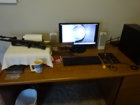If you're not using the same type/brand of bullet you used to measure the original distance to "touching", the accuracy of the measurement that gave you a difference of .066" may be questionable. Even if you are, different Lots of bullets can give different readings. This is because variance in the dimensions/shape of the bullet ogives can give different measurements to "touching" the lands, it's like comparing apples to oranges. How much it might affect your measurement, if at all, is very difficult to say. It would totally depend on how the different the external dimensions of the bullet ogives you used to measure each time were.
I typically remove 10 bullets at random from every new Lot of bullets, mark them carefully, and save them as a "measurement set". I use that specific set at a minimum for the life of that specific Lot of bullets, and usually keep them around even after the Lot is gone. The other thing to consider is that as the lands erode, the lead angle does not always remain the same as it was in a new chamber, often becoming more shallow through wear. This can make it very easy to push the bullet into the lands much farther than "touching" when such measurements are taken.
Reason I mention this is simply because .066" seems like an awful lot of land erosion to me, for only about 1000 rounds. That would be equivalent to the lands eroding 6.6 thousandths for every 100 rounds. At that rate, you'd almost need to repeat a seating depth test as soon as you finished one, until the barrel was shot out. In fact, I'd call that a HUGE amount of land erosion for a .223 Rem. In a .223 Rem Bartlein barrel I recently spun off an F-TR rifle, I had .0105" measured land erosion after 2204 rounds. In other words, about half a thousandth per every 100 rounds. Further, the loads I ran in that barrel for its entire life were quite hot, and I was pushing 90 gr bullets, which is also pretty hard on barrels. I have similar results with other barrels in both .223 Rem and .308 Win. Somewhere around half a thousandth erosion per 100 rounds seems to be about the norm for those calibers. Certainly there may be a difference in the steel used to make Bartlein and Savage barrels, but I'd be rather surprised (and disappointed with Savage) if such a difference meant almost 15 times greater land erosion.
In any event, if you used a different type/brand bullet for the two measurements, it might be worth repeating the measurement using the same bullet as for the original measurement, and being extra careful not to go past "touching". It may be that the land erosion hasn't gone as far as it may have seemed from the first measurement.












